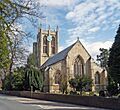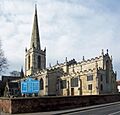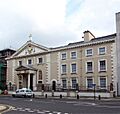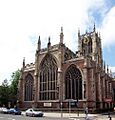Grade I listed churches in the East Riding of Yorkshire facts for kids
The East Riding of Yorkshire is a special area in England with its own local government. It also includes the city of Kingston upon Hull for important events.
Imagine buildings that are so old and special, they get a 'protected' status! In England, these are called listed buildings. They are chosen by the government to make sure they are looked after and not changed without permission. The very best ones are called Grade I listed buildings. These are super important, sometimes even famous around the world! Only a tiny number (about 2.5%) of listed buildings get this top rank. This article tells you about all the amazing Grade I listed churches and chapels in the East Riding of Yorkshire, including the city of Kingston upon Hull.
Contents
Amazing Churches in East Yorkshire
What Makes a Church Special?
Churches have been in this area since Anglo-Saxon times, a very long time ago! You won't find many features from that early period, but you'll see lots of Norman designs. These are from the time after the Normans came to England. Many churches, like St Martin in Burton Agnes and St Mary in Fridaythorpe, show Norman styles.
Most of the churches on this list were built before the 1600s. They all have parts of English Gothic architecture, which means they have tall arches, big windows, and fancy decorations. This style changed over time, and you can see different periods of Gothic design in these churches.
A few churches were built much later, in the 1800s. For example, the Chapel of the Virgin and St Everilda at Everingham (built 1836–39) is a Roman Catholic chapel. It's built in an Italianate style, which looks a bit like old Roman buildings. Other churches, like St Leonard in Scorborough (1857–59) and St Mary in South Dalton (1858–61), were built in a Gothic Revival style. This means they were designed to look like the old Gothic churches, but they were new! Sometimes, older churches also had Gothic Revival parts added to them later.
Building with Local Materials
It was a bit tricky to find good building materials in this area long ago. Much of the land is made of chalk and clay. While there's some limestone and sandstone, it wasn't always the best quality for smooth, cut stone (called ashlar).
Many churches in York used better limestone brought from places like Tadcaster and Thorner. But some churches in the East Riding used a unique material called "cobble." These are rounded stones found on the beach at Holderness. Churches like All Saints in Easington and St Peter and St Paul in Burton Pidsea were built using these interesting cobbles.
Exploring Grade I Churches
Here are some of the incredible Grade I listed churches in the East Riding of Yorkshire:
- All Saints, Adlingfleet: This church is mostly from the 1200s, but it has older doorways from the 1100s. It was fixed up in the 1800s and again in the 1950s. Inside, you can find a special basin called a piscina from the 1200s and many old monuments.
- All Saints, Aughton: Parts of this church are made of limestone, and other parts are brick. It started in the 1100s with a Norman main area (nave). It has carvings of funny, scary figures called grotesques on its tower. The font (where baptisms happen) is round and Norman.
- St Andrew, Bainton: Most of this church was built in the 1330s–1340s. Its spire was damaged by wind in 1715 and later removed. It has a Norman font and a pulpit (where the preacher stands) from 1903.
- All Saints, Barmston: The main parts of this church are originally Norman from the 1100s. The tower and most windows are from the 1400s. It has a Norman font and a special carved stone called a hogback.
- Beverley Minster: This huge church probably started as a monastic church in the 800s. It became a collegiate church (a church for a group of clergy) in 1214 and was added to until the 1400s. After the Reformation, it became a parish church (a church for the local community). It's mostly in the Perpendicular Gothic style, with two tall towers.
- St Mary, Beverley: Started in the mid-1100s, most of this church is from the 1300s and 1400s. Outside, you can see battlements (like on a castle), pointy pinnacles, and flying buttresses (supports). The ceiling from 1445 has paintings of 40 English kings!
- St Edith, Bishop Wilton: This church from the 1100s has a beautifully carved Norman arch and doorway. The tower and spire were added in the 1300s. Inside, there's a choir screen and a font designed by famous architects.
- St Andrew, Boynton: The tower is from the 1400s, and the rest of the church was built later, around 1768–1770. It has a Norman font and old monuments.
- St Mary, Brandesburton: This church started in the 1100s and still has a Norman doorway for the priest. The aisles (side sections) and tower are from the 1200s. Inside, you can find brasses (engraved metal plates) from the 1300s.
- Bridlington Priory: This was once a large Augustinian priory (a type of monastery). After the monasteries were closed down, only the main part (nave) and side sections (aisles) of the church remained. This part became the local parish church. It has two different-looking towers at the west end.
- All Saints, Bubwith: Starting in the 1100s, this church got additions in the next two centuries. The south aisle, clerestory (upper windows), and west tower were paid for by a bishop in the 1400s. It still has a Norman arch and an octagonal font from the 1400s.
- St Andrew, Bugthorpe: This church dates from the 1100s with a Norman arch. The tower was added in the 1400s. The inside was restored and refurnished in the 1930s.
- All Saints, Burstwick: The main part (nave) is from the 1200s, and other parts were added in the 1300s and 1400s. Inside, there are Royal Arms of King Charles I, with a painting of his execution on the back!
- St Martin, Burton Agnes: This church started in the 1000s and is mostly Norman. The tower and clerestory were added in the 1400s. It has a special hammerbeam roof, choir stalls with misericords (small ledges for standing), a Norman font, and monuments from as early as 1337.
- St Peter and St Paul, Burton Pidsea: This church is from the early 1200s, with additions in the 1300s and a tower in the 1400s. The font is octagonal and from the 1200s.
- St Mary, Cottingham: This church is shaped like a cross. The main parts are from the early 1300s, and the central tower from the 1400s. It has many memorials and stained glass windows designed by Jean-Baptiste Capronnier.
- All Saints, Driffield: This church has very old beginnings, even before the Norman Conquest. The main part (nave) and upper windows (clerestory) are from the 1100s. The tower is from the 1400s.
- All Saints, Easington: This church started in the 1100s. It has a special free-standing piscina from the 1100s and medieval wall paintings on one of its arches.
- St Michael, Eastrington: This church dates from the 1000s or 1100s and has Norman features. It has fragments of 1300s stained glass in a window and monuments from the 1400s.
- Chapel of the Virgin and St Everilda, Everingham: This is a Roman Catholic chapel built next to Everingham Hall between 1836 and 1839. It's in an Italianate style, with Corinthian columns and statues of the twelve apostles. The ceiling is a curved tunnel vault.
- St Mary, Fridaythorpe: This church has many remaining Norman features, including the tower, a doorway, and an arch. It was restored in the early 1900s.
- St Michael, Garton: The tower is from the early 1200s, and the main part (chancel) is from later that century. It has a medieval screen with fancy tracery and an octagonal font from the mid-1200s.
- St Michael, Garton on the Wolds: Built around 1132, this church has later additions. Its walls are covered with paintings by Clayton and Bell.
- All Hallows, Goodmanham: This church is said to have started in the 600s on the site of an old pagan temple! The current church is mostly Norman from the 1100s. It has two fonts, one of which was found in a farmyard!
- All Saints, Halsham: This church started in the 1100s. It has a pulpit from 1634 and monuments from the 1400s and later.
- St John of Beverley, Harpham: This church is named after John of Beverley, who was born nearby. It dates from the 1100s and has Norman features. It also has many old monuments.
- St Martin, Hayton: This church looks plain on the outside, but inside it has Norman features and 1600s wall paintings. The tower is from the 1300s.
- St Augustine, Hedon: This church is from the 1200s, with a tower added in 1428. It has a font from the 1300s and a black marble tomb cover from the 1200s.
- All Saints, Hessle: A church was mentioned here in the Domesday Book! The current church is from the 1100s, and the steeple was built in the 1400s. It was changed a lot in the 1800s.
- All Saints, Holme-on-Spalding-Moor: The main part (nave) and side sections (aisles) are from the 1200s, and the upper part of the tower is from the 1400s. It has a 1100s octagonal font and screens carved by Robert (Mouseman) Thompson, who was famous for his mouse carvings.
- St Nicholas, Hornsea: This church is from the 1200s. It has an octagonal font from the 1200s and effigies (sculpted figures) brought from a nearby priory.
- Howden Minster: This was once a very important church with a grammar school attached. After the Reformation, the main part (nave) became a parish church, and the east end became a ruin. The ruins are looked after by English Heritage.
- St Mary, Huggate: The main part (nave) and side sections (aisles) are from the 1100s, and the chancel is from the 1200s. It has a Norman arch and a tower with a spire from the 1300s.
- St Peter, Humbleton: The main parts are from the 1200s, the tower from the 1300s, and the side sections (aisles) from the 1400s. It has part of an alabaster monument from 1637.
- St Nicholas, Keyingham: This church is from the 1100s-1200s. The spire was removed from the tower in 1969. The oldest monument is from 1647.
- All Saints, Kilham: The earliest parts of this church are from the early 1100s, including a Norman main part (nave) and doorway. The chancel is from the early 1300s. It has a sedilia (seats for clergy) from the 1200s and a Norman font.
- St Charles Borromeo, Kingston upon Hull: This Roman Catholic church opened in 1829. It's made of brick with a fancy front in a Classical Revival style, with Corinthian columns. The inside is very decorated with Italian Baroque and Austrian Rococo styles.
- Hull Minster, Kingston upon Hull: Formerly called Holy Trinity, this is one of the largest parish churches in England! It was one of the first English churches to use a lot of brick, especially in its cross-shaped sections (transepts) in the early 1300s. It was mostly built between 1300 and 1425. In 2017, it was rededicated as Hull Minster.
- St James, Sutton-on-Hull, Kingston upon Hull: This church started around 1347. The tower was added around 1400. Inside, it has a tub-shaped font from the 1200s and a chest tomb from around 1349.
- All Saints, Kirby Underdale: The tower and main part (nave) are Norman from the 1000s. A Roman sculpture of Mercury is built into the wall!
- St Mary, Kirkburn: St Mary's was built in the mid-1100s and has many Norman features, especially in its tower and chancel. It has a Norman font and a chancel screen designed by George Edmund Street.
- St Andrew, Kirk Ella: The chancel is from the early 1200s, and the tower, made of contrasting white limestone, was built between 1450 and 1454. Inside, under the tower, are rare remains of a screen from the early 1300s.
- St Peter, Langtoft: The tower and south arch are from the 1200s, and the chancel and north side section (aisle) are from the 1300s. It has an 1100s font from a demolished local church.
- St Catherine, Leconfield: This church has a main part (nave) from the 1100s or earlier, side sections (aisles) from the early 1200s, and the chancel from later that century. Some windows have stained glass from the 1300s and 1400s.
- St Mary, Lockington: This church dates from the 1100s. The tower was rebuilt in the 1600s. It has an 1700s pulpit with a special sounding board. The south chapel has walls lined with 173 panels, each showing a coat of arms!
- All Saints, Londesborough: The south doorway is Norman and has a sundial carved into it. A cross-head from the late 800s or early 900s is built into the wall above the doorway. It also has monuments to the Earls of Burlington.
- All Saints, Low Catton: This church dates from the 1100s and has Norman features. The chancel was largely rebuilt in 1866, and its roof is much higher than the main part (nave). The east window was designed by Edward Burne-Jones.
- All Saints, Market Weighton: The oldest part is the main area (nave) from the 1000s. The tower's lower part is stone, and the upper part, heightened in 1785, is brick. The Norman font is from the 1000s or 1100s.
- St Margaret, Millington: This is a small church with a main part (nave) from the 1100s and a chancel from the 1300s. The south doorway is Norman. Inside, the altar rails were carved by Robert (Mouseman) Thompson.
- All Saints, Nafferton: The main part (nave) was built in the 1100s and has a Norman chancel arch. The chancel is from the late 1200s. It has a special opening called a squint and a tub-shaped font with decorations. All the pews are 1800s box pews.
- St Nicholas, Newbald: This cross-shaped church is thought to be the most complete Norman church in the East Riding! It has four Norman arches where the arms of the cross meet. It dates from around 1140. The font is from the 1100s and is carved with plants.
- All Saints, North Cave: The base of the tower is Norman from the 1100s. The main part (nave) and chancel are from the 1200s. On the south wall of the chancel, there's a painted instruction for Confession and Absolution.
- St James, Nunburnholme: The main part (nave) dates from the 1100s, and the chancel from the early 1200s. The tower and south porch were added around 1902. Inside, there's an 1100s font and fragments of a cross-shaft from around 1000.
- St Wilfred, Ottringham: This church dates from the 1100s. It has a tower with a pointy spire. The octagonal font is from the 1400s, and the church has a full set of 1700s box pews.
- St Patrick, Patrington: This cross-shaped church is mainly from the 1300s, with a spire added to its central tower in the 1400s. It has a sedilia (seats), a piscina (basin), and an Easter Sepulchre (a special place for Easter).
- St Andrew, Paull: This church replaced an earlier one destroyed in 1355 and uses some materials from it. It was damaged during the Siege of Hull in 1643. All the windows have Perpendicular Gothic tracery.
- All Saints, Pocklington: The main part (nave) dates from the 1100s or earlier. The cross-shaped sections (transepts) were added in the 1200s, and the tower and chancel in the 1400s. The font is from the 1100s.
- All Saints, Preston: The chancel is from the 1200s and was rebuilt in 1870. Other parts are from the 1300s to the 1500s. The tower is in the Perpendicular Gothic style. The octagonal font is from the 1400s.
- All Saints, Roos: The chancel is from the 1200s, and the main part (nave) from the 1300s. The tower was built in the 1300s and made taller in the 1400s. There are fragments of medieval stained glass in the upper windows (clerestory).
- All Saints, Rudston: The tower and its arch are Norman from the 1100s. The side sections (aisles) and chancel were built in the 1200s. Inside, there's an 1100s font and a 1300s piscina and sedilia. It also has a memorial to the author Winifred Holtby.
- St Leonard, Scorborough: This church was built in 1857–59 for Lord Hotham and designed by John Loughborough Pearson in the Gothic Revival style.
- All Saints, Shiptonthorpe: The main part (nave) dates from the 1100s. The tower, north side section (aisle), and chancel are from the 1200s. The tower was made taller in the 1400s.
- St Helen, Skeffling: Almost all of this church, except for the 1800s porch, dates from the 1460s. In the chancel, there are three plain sedilia (seats). The font is from the 1400s, and the oldest monument is from 1494.
- St Leonard, Skerne: This is a small church with the main part (nave) and chancel dating from the 1100s. The chancel arch, south doorway, and some windows are all in Norman style. The tower was added in the 1400s.
- All Saints, Skipsea: The main part (nave) and chancel were built in the 1000s, with the tower, side sections (aisles), and upper windows (clerestory) added in the 1400s. Much of the church is in the Perpendicular Gothic style.
- St Augustine, Skirlaugh: This church was built between 1401 and 1405, replacing an older one. It was paid for by Bishop Walter Skirlaw, who was born in the area. It is entirely in the Perpendicular Gothic style.
- St Lawrence, Snaith: This church was founded in Anglo-Saxon times, but the current church dates from 1086. It has a 1200s tower and a 1300s chancel. It also has a monument from 1837.
- St Mary, South Dalton: This is a new church designed by John Loughborough Pearson in the Gothic Revival style. It was built in 1858–61 and has a very tall steeple, 208 feet (63 meters) high! All the inside parts were designed by Pearson.
- St Mary, Swine: This was originally the eastern part of a nun's church from around 1180. It was changed in the 1300s and 1400s. Inside, it has choir stalls with misericords and monuments from the 1300s.
- St Michael and All Angels, Sutton upon Derwent: The main part (nave) dates from the 1100s, and the chancel from the 1200s. The tower was built in the 1400s. Inside, there's a re-set 1100s round arch and pieces of a carved cross from the 1000s.
- All Saints, Thwing: This church dates from the 1100s, with a Norman south doorway and chancel arch. Much of the rest is Perpendicular Gothic. It has a Norman font and monuments from the 1300s and later.
- St Mary, Watton: St Mary's is a brick church built in the 1400s, with parts from the 1200s. Inside, there's a rood screen and a piscina in the south wall of the main part (nave).
- St Peter, Wawne: The main part (nave) dates from the 1100s or earlier, the tower and side sections (aisles) from the early 1200s, and the chancel from later that century. It's built of stone, with some brick repairs.
- St Mary, Welwick: The oldest parts of this church are from the late 1200s. Additions were made in the 1300s, and the tower was rebuilt in the 1400s. In the south side section (aisle), there's a detailed tomb from around 1340 with the effigy of a priest and angels. There are also traces of wall paintings.
Images for kids
-
All Saints Church, Preston - geograph.uk - 723150.jpg
All Saints Church, Preston










































































